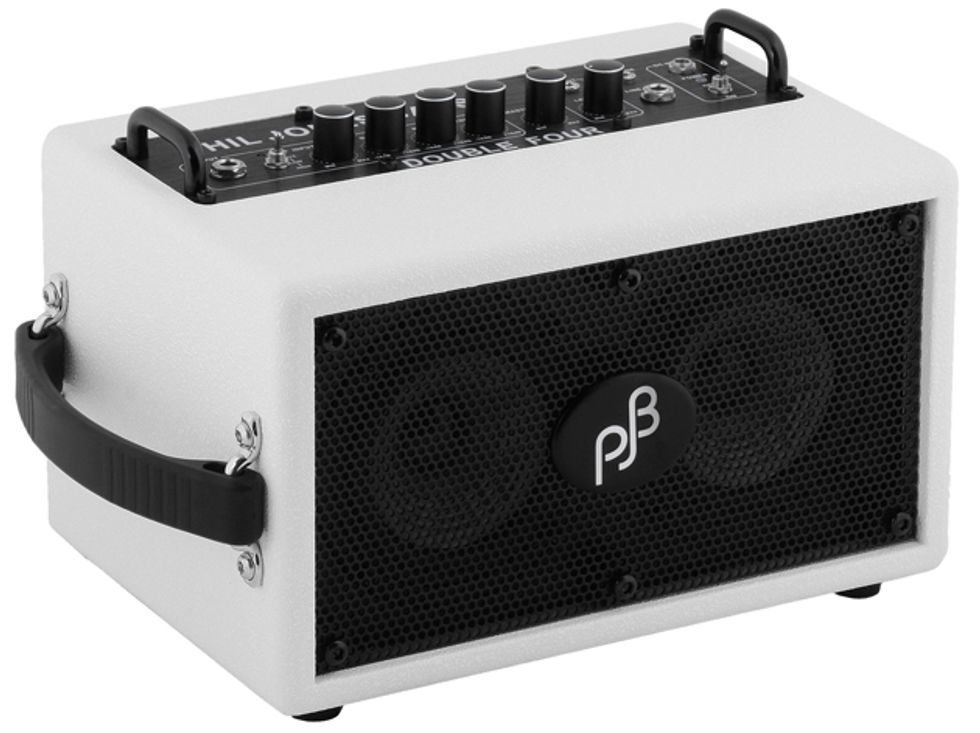Downsizing is a hard pill to swallow. Nobody wants to be told to make do with less. We’re often taught that bigger is better, and this sentiment is echoed repeatedly in the music world, with bass rigs pushing thousands of watts through refrigerator-sized cabs.
Reversing course, Phil Jones Pure Sound has been moving things in a smaller, more scientific direction with the revolutionary 5" Piranha bass driver, the soul of the company’s micro bass amp line. Jones has been making bassists do double-takes with creations that produce big, faithful bass tone from cabinets housing as many as 21 of his wee speakers. Blazing yet another trail, Jones recently introduced the 70-watt Double Four BG-75, a breadbox-sized micro combo that delivers—and delivers well.
Fours?
When I unpacked the Double Four, I held the tiny amp in my hand and gazed back into the box, as if I’d see something I missed. Nope. It was all in my hand—all (almost) 9 pounds of it. The amp is roughly the size of two stacked shoeboxes. I was more than intrigued.
The Double Four is a simple, straightforward combo amp with clean lines and a solid feel. The textured covering looks sprayed-on, like a pickup truck bed liner, which I like because there’s no outer material to peel away over time. The rugged chassis houses simple controls suitable for practicing and small gigs, plus some helpful extras. A mute/low/high mini-switch toggles between low-gain input and a high-gain stage that brings the 70 watts to their full potential. A clip indicator light, a level control, 3-band EQ, and master volume round out the controls. There’s also an 1/8" aux input jack with level control, an 1/8" headphone jack, and a 1/4" line out.
The Mighty Roar.
So how good can an amp this small sound? Is it for real? And should you consider spending $450 bucks on a practice amp?
Plugging in a Sandberg California TT passive, I was happy to hear, well, bass—and lots of it. The 4" speakers sounded full and rich. The tone was authentic and free from coloration. The Double Four had plenty of volume for its size. It handled everything I threw at it, from fingerstyle to slap to pick. It was punchy, tight, accurate, and above all, simple.
Ratings
Pros:
Authentic, uncolored tone from a deliriously small amp.
Cons:
Won’t make it past a drummer on its own.
Tones:
Playability/Ease of Use:
Build/Design:
Value:
Street:
$449
Phil Jones Pure Sound Double Four BG-75
philjonespuresound.com
So how exactly does the Double Fourdo what it does? Phil Jones had already mastered delivering low end via small neo speakers, and then he notched things up with the Rectangular Auxiliary Low Frequency Radiator (RALFR) in the Double Four. It’s a fancy name for a radiator that augments speaker output in 30-to-150 Hz range by redirecting air. Additionally, each speaker is powered by its own amplifier for greater efficiency. It’s difficult to believe the bass response of these 4" speakers.
I field-tested the Double Four at an acoustic rehearsal with a piano player, two acoustic guitarists, and a drummer on cajón. I placed it on the floor for natural resonance and found that positioning it on its side was most convenient for EQ adjustments. Everyone was amazed by how great the amp sounded. The Double Four blazed through rehearsal with no problems, always sounding far bigger than its size.
I didn’t test the amp through a P.A., but the line out has you covered for situations where the Double Four might not be quite powerful enough—a larger coffee house gig, for example. But for a small gig, rehearsal, or songwriting situation, this amp is all you need.
The Verdict.
Playing (and transporting) the Double Four is a joy. No, it won’t replace your high-output stage gear, but that’s not its intent. It elevates the bedroom-sized amp to the upper echelons of tone and portability, so you don’t have to sacrifice tone when rehearsing. It can make acoustic and other low-volume gigs a breeze. It could also be handy backstage, on the bus, or as a personal monitor. And did I mention you can fit it in a backpack? All this makes the Double Four very much worth a test run.








![Rig Rundown: AFI [2025]](https://www.premierguitar.com/media-library/youtube.jpg?id=62064741&width=1245&height=700&quality=70&coordinates=0%2C0%2C0%2C0)












 Shop Scott's Rig
Shop Scott's Rig
![Rig Rundown: Russian Circles’ Mike Sullivan [2025]](https://www.premierguitar.com/media-library/youtube.jpg?id=62303631&width=1245&height=700&quality=70&coordinates=0%2C0%2C0%2C0)














































